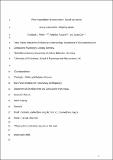Files in this item
From exploitation to cooperation : social tool use in orang-utan mother-offspring dyads
Item metadata
| dc.contributor.author | Voelter, Christoph Johannes | |
| dc.contributor.author | Rossano, F. | |
| dc.contributor.author | Call, J. | |
| dc.date.accessioned | 2016-04-19T10:30:07Z | |
| dc.date.available | 2016-04-19T10:30:07Z | |
| dc.date.issued | 2015-02 | |
| dc.identifier | 167199308 | |
| dc.identifier | c2931d4c-f14c-4466-9388-1e6f8f02ddf0 | |
| dc.identifier | 84921407098 | |
| dc.identifier | 000348449000018 | |
| dc.identifier.citation | Voelter , C J , Rossano , F & Call , J 2015 , ' From exploitation to cooperation : social tool use in orang-utan mother-offspring dyads ' , Animal Behaviour , vol. 100 , pp. 126-134 . https://doi.org/10.1016/j.anbehav.2014.11.025 | en |
| dc.identifier.issn | 0003-3472 | |
| dc.identifier.other | ORCID: /0000-0002-8597-8336/work/37477925 | |
| dc.identifier.uri | https://hdl.handle.net/10023/8635 | |
| dc.description | C.J.V. was supported by a scholarship of the German National Academic Foundation. | en |
| dc.description.abstract | Social manipulation represents an important aspect of human social interactions, including cooperative ones. Yet, little is known about social manipulation of conspecifics in nonhuman great apes. We investigated how orang-utan, Pongo abelii, mothers used their offspring as a means to access food in competitive and cooperative test situations. In the competitive situations, only the offspring could retrieve high-value food rewards. Here, orang-utan mothers often stole the food from their offspring and even coerced them into retrieving it to begin with, by moving the offspring to the test site, guiding their arms and bodies towards the food, and even reorienting their hands so that they would grab the food. However, modifying the task constraints so that mothers were now required to cooperate with their offspring to obtain the food changed the mothers' behaviour completely. Suddenly, mothers cooperated with their offspring by handing them tools that only their offspring could use to activate a mechanism delivering food for both of them. We conclude that orang-utans, like humans, are able to flexibly use conspecifics as a social tool and that this kind of social tool use supports their ability to cooperate. | |
| dc.format.extent | 9 | |
| dc.format.extent | 386545 | |
| dc.language.iso | eng | |
| dc.relation.ispartof | Animal Behaviour | en |
| dc.subject | Cooperation | en |
| dc.subject | Exploitation | en |
| dc.subject | Great apes | en |
| dc.subject | Orang-utan | en |
| dc.subject | Primate cognition | en |
| dc.subject | Social tool use | en |
| dc.subject | BF Psychology | en |
| dc.subject | NDAS | en |
| dc.subject.lcc | BF | en |
| dc.title | From exploitation to cooperation : social tool use in orang-utan mother-offspring dyads | en |
| dc.type | Journal article | en |
| dc.contributor.institution | University of St Andrews. School of Psychology and Neuroscience | en |
| dc.contributor.institution | University of St Andrews. Centre for Social Learning & Cognitive Evolution | en |
| dc.identifier.doi | https://doi.org/10.1016/j.anbehav.2014.11.025 | |
| dc.description.status | Peer reviewed | en |
| dc.identifier.url | http://www.sciencedirect.com/science/article/pii/S0003347214004448#appd001 | en |
This item appears in the following Collection(s)
Items in the St Andrews Research Repository are protected by copyright, with all rights reserved, unless otherwise indicated.

